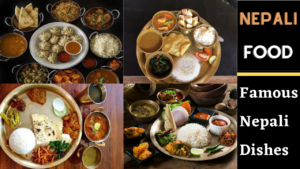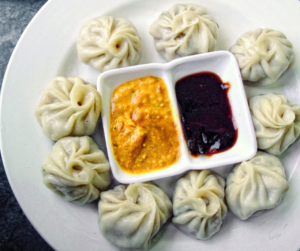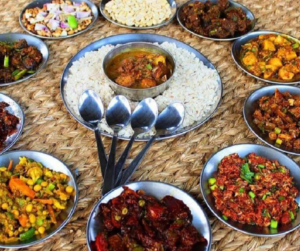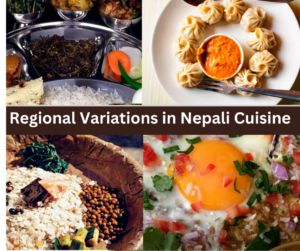Nepali Cuisine Discover Nepali Cuisine: An Introduction
Nepali food may be a relatively unknown and unfamiliar cooking, but it features a lot to offer for those who adore investigating unused flavors and societies. It could be a special mix of Himalayan, Indian, and Tibetan impacts, coming about in differing and flavorful cooking.
 Discover the rich and diverse culinary world of Nepali cuisine. From hearty dal bhat to momos, indulge in mouth-watering dishes that will tantalize your taste buds.
Discover the rich and diverse culinary world of Nepali cuisine. From hearty dal bhat to momos, indulge in mouth-watering dishes that will tantalize your taste buds.
A brief history of Nepali Cuisine
A long culinary tradition has existed in Nepal since antiquity. The country’s unique geographical location, nestled between India and Tibet, has influenced its cuisine over the centuries. Numerous elements, including climate, geography, religion, and cultural traditions, have influenced Nepali food.
The earliest known Nepali cuisine was influenced by the Newars, an indigenous ethnic group in the Kathmandu Valley. With the help of regional foods including rice, lentils, veggies, and meat, the Newars developed a sophisticated culinary culture.
They also developed a unique method of preserving meat using spices and smoke, which is still used today.
Over time, Nepali cuisine was influenced by neighboring countries, particularly India and Tibet. The cuisine became more diverse, with new flavors and ingredients being introduced. The trade routes between India and Tibet also allowed for the exchange of spices and other food products, further influencing Nepali cuisine.
Himalayan, Indian, and Tibetan influences can all be found in modern Nepali cuisine. It is characterized by its utilization of flavors, counting cumin, coriander, and turmeric, and its accentuation on straightforward, generous dishes made with neighborhood fixings.
What makes Nepali cuisine unique?
Because of the numerous different cultural influences and the utilisation of regional ingredients, Nepali cuisine is distinctive in many ways.
Here are a few traits that make Nepali food distinctive: Using spices It is commonly known that Nepali cuisine uses spices to provide food flavor in depth.
Choices for vegetarian lovers and meat eaters: Nepali nourishment offers an assortment of dishes made with meat, poultry, angel, and vegetables that are reasonable for both vegetarian lovers and meat eaters.
Rice, lentils, and veggies are the three main ingredients of Nepali cuisine that are considered to be staples. These are frequently served with pickles and achar, a spicy chutney, on the side.
Momo: A common snack in Nepal is a type of dumpling called momo. It’s constantly served with a fiery tomato sauce and can be filled with a variety of particulars, including vegetables, meat, or cheese.

A distinctive feature of Nepali food is Newari cuisine, which has its roots in the Kathmandu Valley. It has meals like chatamari (a pancake made of rice flour), choila (spicy grilled beef), and bara (a pancake made of lentils).
Generally speaking, Nepali food is distinguished by its use of spices, regional ingredients, and substantial, satisfying dishes that are ideal for the country’s rocky topography.
Staple Foods in Nepali Cuisine
Rice is the staple nourishment in Nepal, and it is served with each supper. Dal, or lentils, is another essential component of Nepali cuisine. Vegetables and meat are moreover commonly eaten, but not as habitually as rice and dal.

Famous Nepali Dishes
One of the most popular Nepali dishes is Mo:Mo, a type of dumpling filled with meat or vegetables and served with spicy tomato sauce. Another staple dish is Dal Bhat Tarkari, which is a combination of lentil soup, rice, and vegetables. Sel Roti, a sweet rice flour bread, and Chow Mein, a stir-fried noodle dish, are also famous Nepali dishes.
Regional Variations in Nepali Cuisine
There are several regional variations in Nepali food, each with its unique flavor profile. Newari cuisine, for instance, is famous for its spicy and flavorful dishes, while Thakali cuisine is known for its use of buckwheat and roasted meat. Sherpa cuisine, on the other hand, features hearty and warming dishes perfect for the cold mountain weather.

Influence of Neighboring Countries on Nepali Cuisine
Nepali food has been influenced by its neighboring countries, particularly India and China. Indian spices, such as cumin, coriander, and turmeric, are commonly used in Nepali dishes. Chinese influence can be seen in dishes such as Chow Mein, which is a staple of Nepali street food.
Nepali Desserts and Beverages
Juju Dhau, also known as “King of Yogurt,” is a famous Nepali dessert made from buffalo milk and served in clay pots. Chiya, or tea, is also a popular beverage in Nepal and is served with almost every meal. Chyang, a rice beer, is a traditional alcoholic beverage that is popular in mountain regions.
Vegan and Vegetarian Options in Nepali Cuisine
Nepali food offers a wide range of vegan and vegetarian options, including dishes such as Aloo Tama Bodi (potato, bamboo shoot, and black-eyed peas curry) and Kwati (a mixed bean soup).
Nepali Cuisine in the Global Food Scene
Nepali food is gradually picking up notoriety within the worldwide nourishment scene, with Nepali eateries popping up in cities around the world. It has a lot to offer for those who love spicy, flavorful
FAQ
What is the origin of Nepali cuisine?
Nepal is a lovely nation found in South Asia, celebrated for its grand Himalayan mountains, differing culture, and scrumptious food. Nepali cooking may be a mix of distinctive societies, counting Indian, Tibetan, and Chinese. The cooking has been affected by diverse variables, counting geology, religion, and the accessibility of fixings.
The geography of Nepal and its impact on Nepali cuisine
Nepal is a landlocked nation with different geology, extending from the tall Himalayan mountains to the prolific fields of Terai. Topography has had a critical effect on Nepali food, as distinctive districts of Nepal have created their claim interesting culinary traditions. For case, the cooking of the precipitous districts is intensely impacted by Tibetan cooking, while the food of the Terai locale is intensely affected by Indian food.
The Influence of Religion on Nepali Cuisine
Nepal could be a multiethnic and multicultural nation with numerous religions, counting Hinduism, Buddhism, and Islam. The different religions have had a significant impact on Nepali cuisine, as many traditional dishes are associated with religious festivals and ceremonies. For example, during the Hindu festival of Dashain, it is traditional to eat meat dishes such as goat curry and chicken curry.
Who owns the cuisine of Nepal?
The ownership of Nepali food is a topic of debate, as different communities in Nepal claim ownership of different dishes. For example, the Newari community claims ownership of traditional dishes such as “Chatamari,” a Newari pizza made with rice flour, minced meat, and eggs. Similarly, the Thakali community claims ownership of traditional dishes such as “Thakali Dal Bhat,” a lentil soup served with rice and vegetables.
What is Nepalese culture?
Nepalese culture is a mix of diverse societies, counting Indian, Tibetan, and Chinese. The culture has had a noteworthy effect on Nepali cooking, as distinctive districts of Nepal have created their claim special culinary traditions. For illustration, the food of the hilly locales is intensely affected by Tibetan food, though the food of the Terai locale is intensely impacted by Indian cooking.
What is famous in Nepal?
Nepal has many delicious dishes that are famous around the world. Some of the most famous dishes include:
Dal Bhat: a lentil soup served with rice and vegetables.
Momo: steamed dumplings filled with meat or vegetables.
Choyla: a spicy grilled meat dish.
Sel Roti: a sweet rice flour donut.
Kwati: a mixed bean soup.
Where did cuisine originate?
The beginning of Nepali food can be followed back to old times when diverse communities in Nepal began to create their claim interesting culinary traditions. The food has been affected by diverse components, counting topography, religion, and the accessibility of ingredients. Over time, Nepali food has advanced and adjusted to distinctive changes, and nowadays it may be a wealthy and differing food with numerous one of a kind dishes.
Why is it called Nepali?
The term “Nepali” refers to the people and the culture of Nepal. The cuisine is called Nepali because it is the traditional cuisine of Nepal. The term “Nepali” to reflects the assorted nature of Nepali nourishment, which has been impacted by diverse societies and traditions.
In conclusion, Nepali food is a wealthy and different cooking that reflects the culture, geology, and history of Nepal. The Nepali cuisine has been affected by distinctive variables, counting geology, religion, and the availability of ingredients. Nepali cuisine is famous around the world for its delicious dishes, including Dal Bhat, Momo, and Choyla. Regardless of who owns the cuisine, Nepali cuisine is a proud reflection of the Nep
Read More: Related Article

